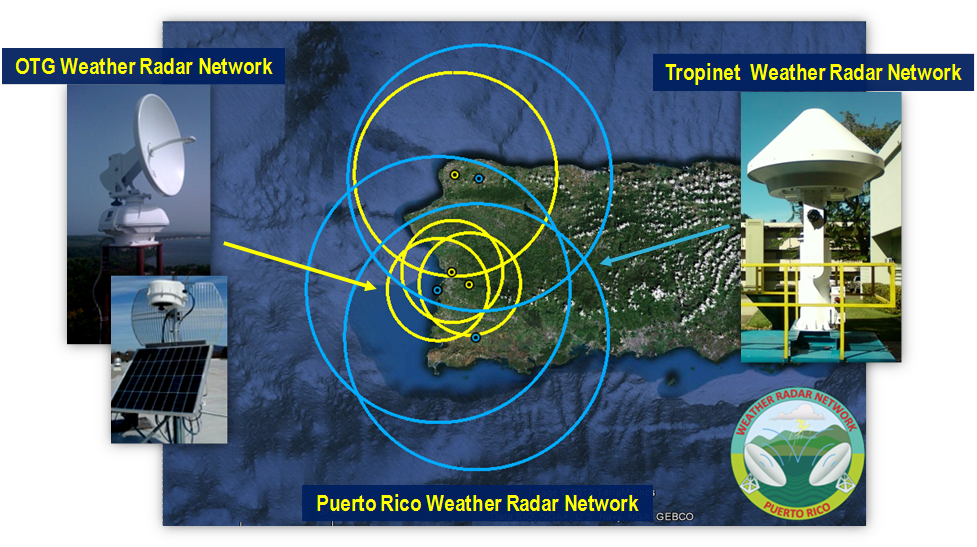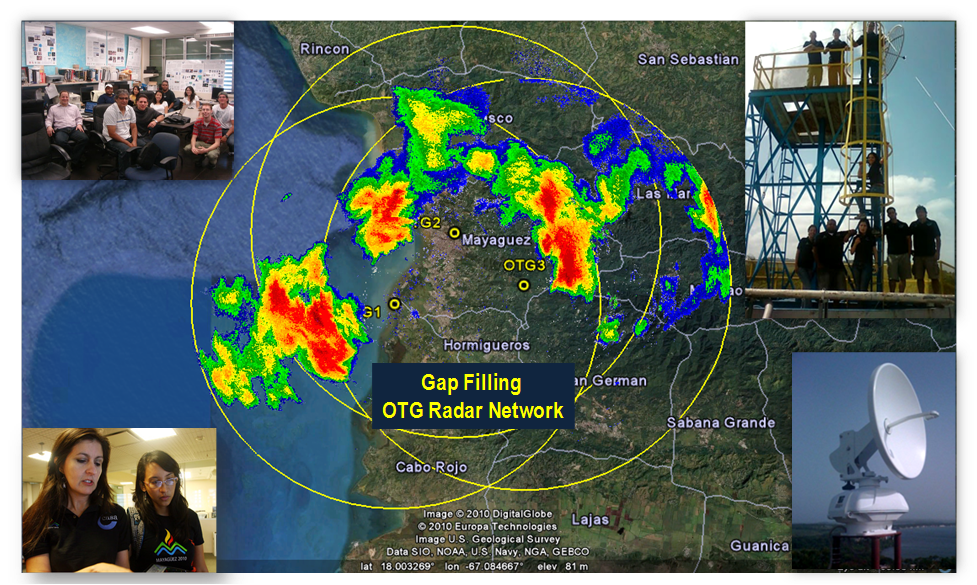Puerto Rico Weather Radar Network
The Puerto Rico weather radar network in connection with CASA's strategic plans, seeks to advance fundamental electromagnetic knowledge of the atmosphere and to provide societal benefits by improving the observation, detection and prediction of weather and climate phenomena in tropical environment and variable terrain. The network is composed of two different X-band weather radar networks in development/operation: namely CASA Student-Led OTG (Off-the-Grid) Radar Network and MRI Tropinet Radar Network. Both radar networks will operate in a collaborative and adaptive manner based on end users needs. An interdisciplinary team of students and faculty members from the CASA core partners and from areas such as electrical, computer and civil engineering, computer and social sciences and meteorology, works in the development of these networks. Development and operation of the weather radar networks is funded by the NSF Engineering Research Center CASA (for OTG radar network) and the NSF Major Research Instrumentation (MRI) Program (for Tropinet radar network).

Off-the-Grid Weather Radar Network
CASA is developing several radar network concepts based on low-cost radars. One of such concept has been deployed at western Puerto Rico in conjunction with CASA academic partner, the University of Puerto Rico-Mayaguez (UPRM), using a network of simple, single-polarization radars that are not dependent on existing infrastructure, operating using solar energy and ad-hoc wireless networks, and providing gap-filling data with improved temporal and spatial resolution. A team of CASA graduate and undergraduate students from several CASA partner institutions designed, assembled and installed an "Off-the-Grid" (OTG) solar-powered and wireless radar system in a region of western Puerto Rico that covers a crucial 1.5 km-high atmospheric weather-monitoring gap from the National Weather Service (NWS) Doppler radar in that mountainous region. This design grew entirely out of a student-led research project where the group of undergraduate and graduate students has led all aspects of this project. Thus, this project is innovative not only in radar network design, but also in the education of engineering students.

A proof-of-concept campaign of the OTG weather radar network design through deployment and experiments conducted in western Puerto Rico was coordinated by UPRM students and the NWS Office in San Juan. A network of three such radars was then operated during the Central American and Caribbean Games (CAC) in the summer of 2010 in conjunction with the US National Weather Service (NWS). Data from our test network was used to identify small-scale rain cells with better temporal and spatial resolution, and with lower-level coverage, than the operational NEXRAD installation in Puerto Rico. The key to retrieving such useful data was to configure the radars with overlapping coverage, operate them at short range, and use image mosaics to improve the data quality above what would be achieved with a single radar.
During 2011, talks were given at different venues based on the results obtained by operating the OTG network during the CAC summer games, resulting in local and international interest in the OTG radar network concept. This "Off-the-Grid" (OTG) concept is one that might provide a means to monitor rainfall and provide useful data in those regions of the world where it is not feasible or cost-effective to deploy more costly, and more accurate, radars. Moreover, this project has potentially significant implications for the future of meteorology, and also provides value to the engineering students who are gaining real-world, hands-on experience in providing state-of-the-art technical services in an international setting, with very little supervision. For more information on the CASA OTG project please visit http://stb.ece.uprm.edu/.
Tropinet Weather Radar Network
An NSF MRI grant was awarded to UPRM for the development of a network of three short range dual polarized X-band Doppler radars. The Tropinet network will provide the capabilities for studying and understanding weather phenomena in the Puerto Rico tropical and mountainous environment with the necessary volume coverage and resolution. The radars were designed to operate in a collaborative network capable of targeting an event from multiple angles, to accurately estimate rainfall levels near the ground, and to detect precursors of future storms, all in response to changing end-user needs as demonstrated in the CASA IP1/IP5 radar network.
The radars are being developed in a collaborative manner between CASA academic partners Colorado State University (CSU) and UPRM. A Managing System Control and Decision Center (MSCDC) which is an integral part of the operation of the system will be developed in collaboration with University of Massachusetts Amherst (UMass). The first radar node of the Tropinet network was installed in March 2012 and site preparations are underway for the installation of the other two nodes that will comprise the Tropinet weather radar network. It is expected that the Tropinet network will cover the lowest part of the atmosphere and will supplement the current NOAA/NWS S-band radar coverage. Data from the Tropinet network will be used to perform the on-site data quality assessment and calibration of the OTG radar network.
This project will provide opportunities in a new area of research and research training through increase interaction between students and faculty from UPRM, CSU, UMass and the National Weather Service. A significant outcome of this project will be the hands-on training that faculty, graduate and undergraduate students from UPRM will have in the construction, operation, calibration, and eventually research activities derived from the data analysis of this network.
|